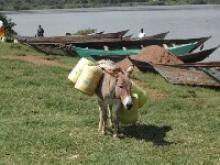Labour-saving technologies and practices: pack animals and animal drawn carts
Human porterage (either on the head, shoulders or back) is common in many rural areas, particularly where access roads are in a poor condition. This practice describes how to use animals such as horses and oxen for transportation.
Description
1. Features of using pack animals
- Donkeys are used for transporting produce, firewood and water.
- Simple frames are shaped and padded so that they comfortably fit onto the backs of donkeys.
- They are commonly used to carry loads.
- Often used by women because donkeys have relatively low status.
- Usually not eaten and not slaughtered at funerals.
2. Features of harnessing
2.1 Bovines (oxen)
- Yokes are used for bovines.
- Occasionally collar harnesses are also used when they are used singly and not in a pair.
- Yokes should be shaped or padded to fit the neck or hump of the ox, to minimize injuries and maximize pull.
- Yokes are connected to the front end of a central drawbar.
2.2 Equines (horses)
- Collar harnesses with breast straps for equines.
- Using yokes can seriously injure equines.
- Carts for single animals use a drawbar on either side of the animal.
- When equines are used in pairs, a central drawbar is used and is connected at its front end to the collar to control direction.
- The pull from the collars is connected by ropes to "swingle trees", which are then connected to an "evener", which is then connected to the base of the drawbar.
- If this system is not used with collars then all the strain of pulling the cart may go onto only one of the animals.
3. Features of carts
- Typical carrying capacities and size.
- Cart pulled by single donkey: 500 kg carrying capacity, load area around 1 m x 1.2 m.
- Cart pulled by single ox: 1 000 kg.
- Cart pulled by pair of oxen: 1 500 kg carrying capacity, load area around 2 m x 1.5 m.
- The cart should be designed so that the centre of gravity of the load is placed over the axle.
- When the cart is fully loaded, including the driver sitting on the cart, the weight transferred to the neck of the animals should not exceed 20 kg and should never pull upwards on the throat.
- Carts are usually made of wood and sometimes of sheet metal.
- A strong but lightweight structure is desirable.
- The bearings, axle and wheels are the most critical components of carts and the ones that break down most frequently.
- Pneumatic wheels and well-designed axles with roller bearings reduce breakdowns.
- An increasing range of low-cost but reliable designs has become available over the last decade.
4. Advantages
- Labour-saving
- Substantially reduces drudgery and much higher loads can be transported using draught animals compared to manual methods.
- Livelihood resilience strengthening
- Improved transport capability improves business development potential (such as timely marketing of farm produce) and reduces transport bottlenecks and delays.
- Livelihood diversification
- Opportunities for off-farm earning potential through the provision rural transport services.
- Equipment
- Relatively easy to manufacture if other draught animal equipment is already manufactured.
- Skills
- If a household already has draught or pack animals, few additional skills are required.
5. Disadvantages
- Equipment
- Carts require local manufacture.
- Cost and risk
- Significant investment and operating costs compared to manual methods; hence there is a moderate financial risk.
- Skills
- Requirements are high since there is a need for extensive knowledge and skills in animal husbandry and working with draught animals; skilled operators; and trained animals.
- Infrastructure
- Effective presence of veterinary services as well as repair and maintenance services to enable prompt repairs and the creation of moderate road structures to use carts.
Figure 1. Donkey

©FAO/TECA
6. Agro-ecological zones
- Tropics, warm.
7. Related/associated technologies
- Draught animal power technologies in East Africa: ID 4535.
- Development of tools for draught animals: ID 4483.
- Labour-saving technologies and practices: draught animal power and implements: ID 7306.
- Improving the productivity of draught animal power in sub-Saharan Africa: ID 4467.
- Labour-saving technologies and practices: draught animal powered and motorised crop processing: ID 7307.
- Labour-saving technologies and practices: Draught Animal Power (DAP) planters and weeders: ID 7305.
8. Objectives fulfilled by the project
8.1 Labour saving technology (LST)
The practice reduces manpower needed for transportation compared with manual methods.
8.2 Pro-poor technology
The practice improves productivity and saves time.
Autor: Rural Infrastructure and Agro-industries Division (Agricultural Machinery and Infrastructure) AGS in FAO
Organización: The Food and Agriculture Organization of the United Nations FAO TECA
Año: 2020
Tipo: Prácticas
Texto completo disponible en: https://www.fao.org/teca/en/technologies/7311
Idioma utilizado para los contenidos: English
